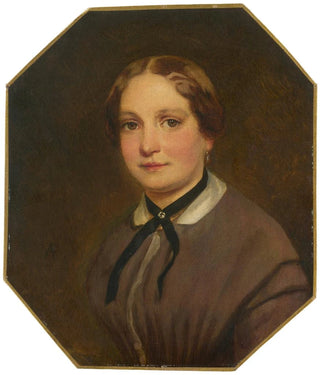Art print | Portrait of his sister Emilie 1827-1873 - Anselm Feuerbach


View from behind

Frame (optional)
In the world of art, some works transcend the mere frame to become witnesses of emotions, relationships, and eras. The "Portrait of his sister Emilie" painted by Anselm Feuerbach between 1827 and 1873 is one of those creations that captivate the mind and soul. This painting, which illustrates tenderness and the complexity of family bonds, immerses us in the intimacy of a fraternal relationship, while offering a glimpse into the artistic concerns of the 19th century. Through this portrait, Feuerbach does not merely depict a figure but evokes a rich inner world where gentleness and melancholy blend harmoniously.
Style and uniqueness of the work
Anselm Feuerbach's style is distinguished by its romantic approach and its ability to capture the essence of its subjects. In the "Portrait of his sister Emilie," the delicacy of features and the subtle use of colors testify to his skill in playing with light and shadow. The composition is carefully orchestrated, with each element contributing to creating an intimate atmosphere. Emilie's facial expression, both serene and reflective, illustrates the depth of her character and invites the viewer to ponder her thoughts and emotions. This painting is a perfect example of how Feuerbach manages to transcend the simple portrait to create a work of art with great emotional impact.
The artist and his influence
Anselm Feuerbach, born in 1829 at the end of a period of artistic upheavals, knew how to navigate between tradition and innovation. Influenced by Romanticism and Classicism, he developed a style that is uniquely his own, blending elements of these currents to create works of great depth. His work is marked by a constant search for beauty and harmony, both in portraits and in the historical scenes he created. Feuerbach also had an impact on his contemporaries, inspiring many artists to explore themes of family and introspection. His ability to capture the human soul through portraiture made him an emblematic figure of his time, and

Matte finish

View from behind

Frame (optional)
In the world of art, some works transcend the mere frame to become witnesses of emotions, relationships, and eras. The "Portrait of his sister Emilie" painted by Anselm Feuerbach between 1827 and 1873 is one of those creations that captivate the mind and soul. This painting, which illustrates tenderness and the complexity of family bonds, immerses us in the intimacy of a fraternal relationship, while offering a glimpse into the artistic concerns of the 19th century. Through this portrait, Feuerbach does not merely depict a figure but evokes a rich inner world where gentleness and melancholy blend harmoniously.
Style and uniqueness of the work
Anselm Feuerbach's style is distinguished by its romantic approach and its ability to capture the essence of its subjects. In the "Portrait of his sister Emilie," the delicacy of features and the subtle use of colors testify to his skill in playing with light and shadow. The composition is carefully orchestrated, with each element contributing to creating an intimate atmosphere. Emilie's facial expression, both serene and reflective, illustrates the depth of her character and invites the viewer to ponder her thoughts and emotions. This painting is a perfect example of how Feuerbach manages to transcend the simple portrait to create a work of art with great emotional impact.
The artist and his influence
Anselm Feuerbach, born in 1829 at the end of a period of artistic upheavals, knew how to navigate between tradition and innovation. Influenced by Romanticism and Classicism, he developed a style that is uniquely his own, blending elements of these currents to create works of great depth. His work is marked by a constant search for beauty and harmony, both in portraits and in the historical scenes he created. Feuerbach also had an impact on his contemporaries, inspiring many artists to explore themes of family and introspection. His ability to capture the human soul through portraiture made him an emblematic figure of his time, and






